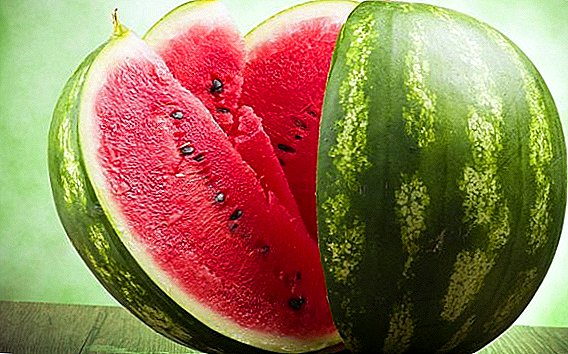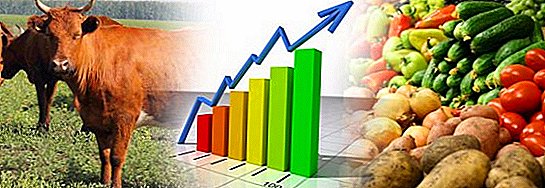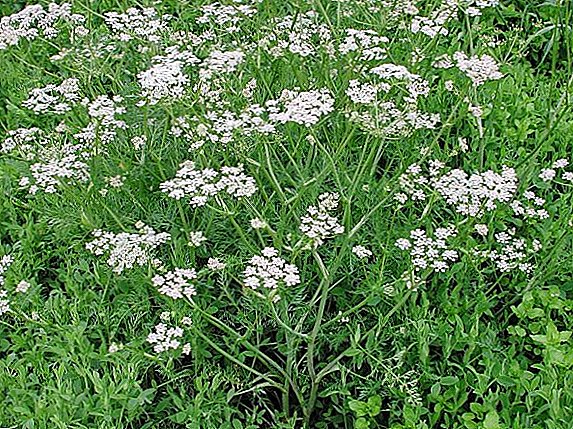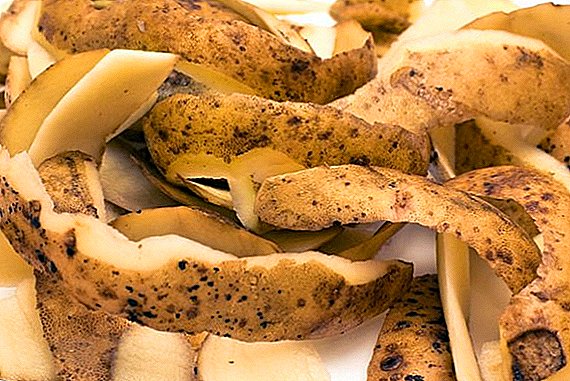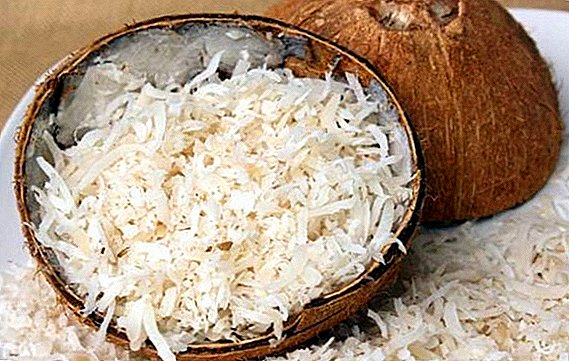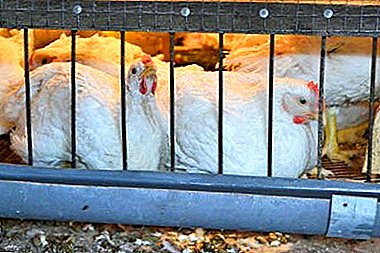
In connection with the wave of "revelations" of well-known food producers, people are seriously concerned about the quality of the food they consume and what they feed the children. It is not surprising that natural, farm products are becoming increasingly popular.
If you are proud of the quality of your poultry meat and are ready to deliver it to the shelves, carefully consider how you can provide the necessary volumes. Most often, novice farmers are very limited in the area that can be used for keeping and walking chickens. Here the best option would be keeping chicken in meat cages.
Pros and cons of cellular content
 With the usual "floor" keeping of birds it is difficult to grow large livestock, especially in a small area. When the birds struggle too much for food, water and space. The first chickens are dying, they can simply crush as the weakest and most vulnerable. To avoid this, multi-tier structures from cages containing 20-25 birds are used.
With the usual "floor" keeping of birds it is difficult to grow large livestock, especially in a small area. When the birds struggle too much for food, water and space. The first chickens are dying, they can simply crush as the weakest and most vulnerable. To avoid this, multi-tier structures from cages containing 20-25 birds are used.
Pros:
- The ability to keep on the same area 3-5 times more chickens without compromising their health.
- Mass gain in broilers is faster, as the bird is limited in movement and all calories go into growth and mass.
- Food is consumed more efficiently, chickens can not scatter it and are saturated with a smaller amount.
- Litter immediately removed from the cage, falling on the pallet. Birds do not peck it and do not enter into the feeder, do not infect.
- The process of feeding, cleaning and daily inspection is significantly reduced.
- Limiting contact with all livestock prevents the spread of infection.
- No need for litter.
- Cleaning troughs and drinkers is easier, conditions are better.
Minuses:
- the cost of buying or making cells;
- the cost of additional lighting, heating and ventilation. But in terms of 1 head and 1 kg gain, the costs are more than repaid;
- meat tastes are lower than those of free-range birds;
- the need for daily cleaning;
- the feed must be balanced, the birds become sensitive to it. They do not have the ability to independently obtain various supplements;
- with a lot of weight, chickens have problems with legs and naminas on the chest, this reduces the quality of the carcass;
- after each batch of birds must be thorough disinfection.
Care rules
 Unlike free-range chickens, birds kept in cages do not have a chance to move to a cooler or brighter place. Creating the most comfortable conditions for chickens is completely dependent on the farmer. Purchase temperature and humidity sensors and carefully monitor their readings and the microclimate in the room.
Unlike free-range chickens, birds kept in cages do not have a chance to move to a cooler or brighter place. Creating the most comfortable conditions for chickens is completely dependent on the farmer. Purchase temperature and humidity sensors and carefully monitor their readings and the microclimate in the room.
The more comfortable the conditions, the less chickens get sick and the faster they gain weight. And the main indicator of a good microclimate is the appearance and activity of birds. Mandatory conditions that must be observed: temperature, adequate lighting, an established ventilation system and the optimum level of humidity.
Let us consider in more detail these microclimate conditions:
- The humidity level must be maintained within 60-70%. When these indicators decrease, the birds lose their appetite, they are tormented by thirst, their appearance is disheveled. With increased humidity chickens become lethargic and slow, breathe heavily.
- A well-established ventilation system is necessary for supplying fresh air and lowering the temperature in the summer months.
- The lighting used is combined: common for the whole room and additional for the smallest chickens. Adjusting the lighting, make sure that each cell receives a sufficient dose of ultraviolet radiation. Otherwise, do not avoid beriberi and rickets. Plus, the longer you organize your daylight hours, the more your chickens will eat and grow faster.
- When setting the temperature regime, remember that the more adult broilers become, the more heat they emit. Do not let them overheat, adult birds enough 18-20 degrees.
- Among other things, do not forget to clean the litter on time. It is harmful for the chickens to breathe ammonia fumes, it provokes respiratory and infectious diseases. In small chickens it is enough to clean every 5-7 days, for those that are older, every 2-3 days, and before slaughter every day.
Zootechnical norms:
- At 1m2 hold no more than 25 birds.
- In one cage 0,5m2 10 day-old chicks.
- The round feeder is designed for 40-50 birds, in the form of a groove 2-2.5 cm in length per head.
- Nippelny drinking bowl on 10-12 heads, vacuum on 50 chickens, in the form of a trench on 2 cm of length on 1 head.
Home breeding equipment
In the shops of poultry farms and in large-scale production of batteries from cells with chickens are 4-6 tiers. In the private sector 2-3 tiers are enough. The cages or equipment for keeping broilers in them can be purchased industrially or can be made with your own hands if you have the necessary materials.
Cell structure:
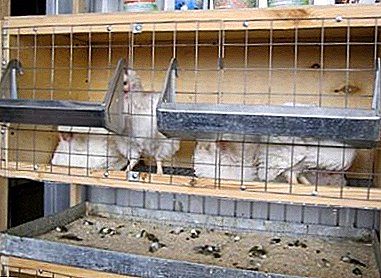 First of all, the frame of wooden or metal guides.
First of all, the frame of wooden or metal guides.- The main material of the walls and floor grid. It is an inexpensive and durable material that will provide the necessary ventilation and light penetration.
- The mesh bottom of the fine-meshed mesh, so that the chicks are not injured. But the size of the cells is sufficient for the droppings to fall on the downstream pallet and not to accumulate on the floor.
- The front wall is in the form of a longitudinal lattice or a grid with wide cells through which the hen can stick its head and reach the feeder normally.
- A feeding trough-chute is hung on the front wall of the cells with manual feeding.
- When mechanized, automatic feeding in the center of the cage is a trough in the form of an inverted glass on a plate, the so-called "carousel" or "umbrella".
- Over the feeder chute or additional trays for chickens up to 20 days, so that it is more convenient for them to reach out to food.
- Lateral, transverse partitions are recommended to make mesh for better ventilation.
- Drinkers, gutters, or vacuum, nipple type are hung on the transverse partitions. Chickens under the age of 10 days only vacuum so that the young will not splash water.
- Door on the front wall for catching and landing birds. For meat inspection, the original settlement.
- The pallets below should be easily extended to clear litter.
- In large poultry farms, a mechanized belt removal system is used.
IMPORTANT: It is more expedient to settle the smallest chickens on the top tier of the cages, and the largest at the bottom. So you will provide kids with maximum lighting and warmth. In addition, birds of the same age easier to get along with each other.
Recommended standards for feeding, heat and lighting:
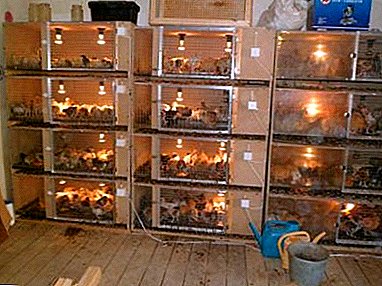 Chicks 0-5 days need lighting for 23 hours, temperature 34 degrees and 15-20g of feed per day;
Chicks 0-5 days need lighting for 23 hours, temperature 34 degrees and 15-20g of feed per day;- at the age of 6-18 days coverage 20 hours, temperature 28 degrees, feed from 25 to 80 g per day;
- from 19 days fattening begins, lighting 18 hours, temperature 25 degrees, feed 100-150 g / day;
- closer to the slaughter from the 38th week, lighting 16-17 hours, the temperature approaches 20 degrees, feed give 160-170 g / day.
Growing stages
Broilers - hybrids of meat breeds, which are characterized by rapid growth and weight gain. When growing broilers, the main goal is to get the maximum weight gain in the shortest possible time. This approach is very different from the breeding of oviparous breeds.
They grow no longer than 50-70 days. With further cultivation, more than 70 days, the increase is reduced, and feed consumption increases.
Chickens are advised to buy 10-day olds, up to this age the highest mortality rate. Chickens are not divided by sex and are grown together. Fattening up to 50-70 days, chickens grow 2.3-2.5 kg, after which they are slaughtered.
NOTE: A part of the livestock of 20-25% is taken for early slaughter in 35 days, from the largest individuals. Free up space and eliminate competition for food, food.
A heavy bird more often sits on its feet, problems with ligaments due to the lack of movement, crowding, space constraints, in cage conditions. Usually, first clean the males, after a week of chickens. Males are larger, grow faster.
There are two ways to grow:
- Seasonal, when chickens are purchased in the spring and slaughtered in the fall.
- Or year-round, when a new batch of chickens bought every three months.
Is it possible to keep chickens outside?
In warm weather and in good weather, it is perfectly acceptable to keep the cages with chickens on the street. For the convenience of transporting cell batteries, the bottom can be equipped with wheels.
Fresh air and natural light will have a most beneficial effect on productivity. It is also the prevention of rickets in chickens, but they can only be taken out from the age of 2 weeks. Make sure that the birds do not overheat or, on the contrary, do not freeze.
So, for the successful content of broilers in the cells it is necessary:
- maintaining a favorable microclimate in the room where birds are kept;
- observance of zootechnical norms;
- compliance with acceptable sanitary and hygienic conditions.
Follow these rules and your products will definitely occupy an honorable place on the shelves among environmentally friendly products!


 First of all, the frame of wooden or metal guides.
First of all, the frame of wooden or metal guides. Chicks 0-5 days need lighting for 23 hours, temperature 34 degrees and 15-20g of feed per day;
Chicks 0-5 days need lighting for 23 hours, temperature 34 degrees and 15-20g of feed per day;
